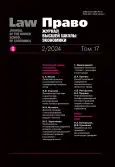Зарубежный опыт правового регулирования технологии «дипфейк»
- Авторы: Виноградов В.1, Кузнецова Д.1
-
Учреждения:
- Национальный исследовательский университет «Высшая школа экономики»
- Выпуск: Том 17, № 2 (2024)
- Страницы: 215-240
- Раздел: Право в современном мире
- URL: https://journal-vniispk.ru/2072-8166/article/view/317744
- DOI: https://doi.org/10.17323/2072-8166.2024.2.215.240
- ID: 317744
Цитировать
Полный текст
Аннотация
Ключевые слова
Об авторах
В. Виноградов
Национальный исследовательский университет «Высшая школа экономики»
Email: vavinogradov@hse.ru
ORCID iD: 0000-0001-8490-2893
Д. Кузнецова
Национальный исследовательский университет «Высшая школа экономики»
Email: dvkuznetsova@hse.ru
ORCID iD: 0009-0003-4059-865X
Список литературы
- Batoev V.B. (2023) Using “deepfake” technology in operational-search activities. Juridicheskaya nauka i praktika. Vestnik Nizhegorodskoi akademii MVD=Legal Science and Practice: Bulletin of the Nizhny Novgorod Academy of Internal Ministry, no. 1, pp. 70-76 (in Russ.)
- Blitz M.J. (2020) Deepfakes and other non-testimonial falsehoods: when is belief manipulation (Not) First Amendment speech. Yale Journal of Law & Technology, vol. 23, Fall, pp. 161-300.
- Burnham W. (2006) Legal system of the USA. Moscow: New Justice, 1216 p. (in Russ.)
- Chng K. (2023) Falsehoods, foreign Interference, and compelled speech in Singapore. Asian Journal of Comparative Law, no. 2, pp. 235-252.
- Goodfellow I.J. et al. (2014) Generative adversarial nets. In: Advances in Neural Information Processing Systems. Montreal: University Press, pp. 2672-2680.
- Hine E., Floridi L. (2022) New deepfake regulations in China are a tool for social stability, but at what cost? Nature Machine Intelligence, no. 4, pp. 608-610.
- Joost L. (2023) Place for illusions: deepfake technology and the challenges of regulating unreality. University of Florida Journal of Law and Public Policy, vol. 33, no. 2, pp. 309-332.
- Kobis N.C., Dolezalova B., Soraperra I. (2021) Fooled twice: people cannot detect deepfakes but think they can. iScience, vol. 24, issue 11, p. 103364.
- Kosikhina S.S., Shvets A.V. (2022) Legal system of the PRC: textbook. Blagoveshchensk: Amur State University, 90 p. (in Russ.)
- Troshchinsky P.V. (2016) Legal system of China. Moscow: Nauka, 472 p. (in Russ.)
- Lee H., Lee T. (2023) Between two Acts: competing narratives, activism and governance in Singapore's digital sphere. Internet Histories, vol. 7, no. 4, pp. 295-312.
- Li Y. (2023) Implementing rule of law concept in the digital sphere: China's experience. Legal Issues in the Digital Age, no. 4, pp. 114-133.
- Manique A.E. et al. (2023) Industry approaches in handling online exploitation of children: a comparative study of policy, guidelines and best practices in Malaysia, Singapore and Australia. Cogent Social Sciences, no. 2.
- Pfefferkorn R. (2020) “Deepfakes” in the courtroom. Boston University Public Interest Law Journal, vol. 29, no. 2, pp. 245-276.
- Skibba R. (2020) Media enhanced by artificial intelligence: can we believe anything anymore? Engineering, vol. 6, issue 7, pp. 723-724.
- Soon J. (2022) A comparative analysis of legislative protection from harassment: a view from Singapore. Oxford University Commonwealth Law Journal, no. 2, pp. 177-204.
- Young N. (2019) Deepfake technology: complete guide to deepfakes, politics and social media. North Charleston (S.C.): Independently published, 160 p.
Дополнительные файлы








